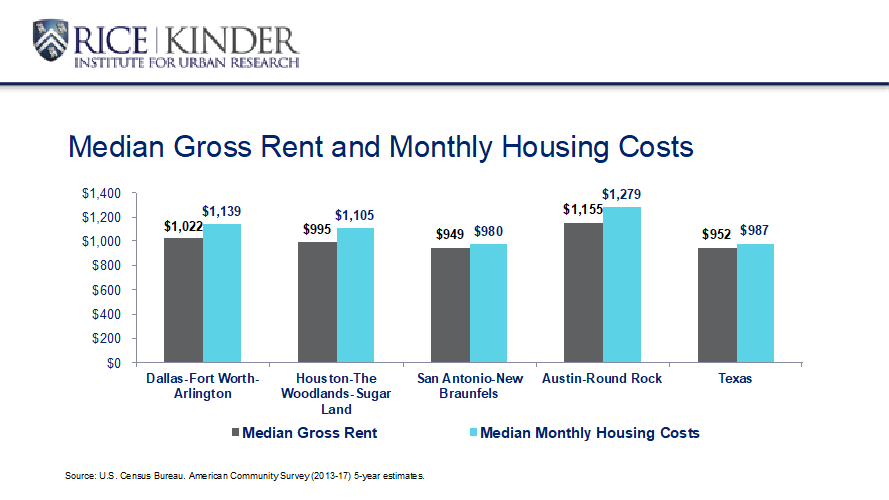On Thursday, the Kinder Institute spoke to the Texas House of Representatives Urban Affairs Committee. We used our opportunity to present information about demographic and housing trends in the state’s cities and metropolitan areas.
To start, Bill Fulton, director of the Kinder Institute, highlighted the fact that Texas is not only an urban state, with 85 percent of residents living in metropolitan areas, but that the “Big Four” metro areas of the Texas triangle—Houston, Dallas, San Antonio and Austin—contain 65 percent of the state’s population and represent about 77 percent of the state’s overall economic activity. Houston and Dallas alone are two of the five largest metro areas in the nation and continue to grow.
What these figures make clear is that Texas’ metros are driving forces of the state. Working to keep metros thriving and ensuring they provide opportunities to all residents, therefore, should be at the top of the Legislature’s to-do list this session and into the future.
To further show the influence of the metro areas, we turned to the demographics of the state. Following the lead of our annual Kinder Houston Area Survey, we pointed out that Texas, like its cities, is becoming a much more diverse state. The population of Latino Texans is growing by the largest number and, across the state, Asian populations are growing at the fastest rate.
Crucially, we noted that Texas’ diversity is coupled with a major youth movement. As the chart below shows, Texas’ non-Anglo residents make up the majority of every age group until you reach 56-64. As Stephen Klineberg, founding director of the Kinder Institute, argues, this reality means Texas must find ways to ensure that these young people are prepared to lead the state into the future, which requires access to education, jobs and safe, affordable homes.

Change of age and race demographics in Texas. Credit: The Kinder Institute
Across the state, people from low-to-moderate incomes are finding it hard to afford homes and apartments (either as renters or owners) in fast-growing communities, especially near jobs and high-rated schools. It’s as much a struggle in the oil-boom towns of the Permian Basin as it is in metro Houston. Part of the challenge is that not enough middle- and low-market units are built or preserved. Most new construction in cities like Houston has been geared toward the upper end of the market. Further deflating supply of affordable units is the fact that older, affordable units are being demolished to make way for more expensive ones.
Another major hurdle is that across the state’s major metros, housing and rent prices have been going up, but incomes have remained more or less static. As the chart below shows, both renters and homeowners spend right around $1,000 a month in housing costs. For many households that is well more than the recommended limit of spending no more than 30 percent of your income on housing. When a household spends more than 30 percent on housing, other essentials - from food to education to healthcare - often get shorted.

Median gross rent and monthly housing costs in Texas' largest metropolitan areas. Credit: The Kinder Institute
To close our comments we highlighted three other interlocking challenges between housing and growth.
First, we noted the interplay between disasters and vulnerable housing. We highlighted forthcoming work conducted by the Kinder Institute and our partners, which identifies nearly 167,000 flood-vulnerable multi-family units in Harris County alone. Addressing such vulnerabilities and ensuring adequate numbers of safe homes for all Texans is a major challenge.
Second, we highlighted our work on regional governance noting that the expansive nature of Texas’ metropolitan growth results in major infrastructure demands. The costs of providing services are borne by cities, counties, special districts, and the state alike. Maintaining essential services such as sewer, water and transportation infrastructure across our metropolitan areas is already an immense challenge and one that will only grow in the future.
Finally, we pointed out the need for housing and growth discussions to be tied to equitable and accessible transportation options for all residents. If residents live far away from job centers and amenities, their options for success are limited. All levels of government need to work to ensure a range of mobility options connect our growing regions together and afford people the ability to access opportunity.
Our testimony and others alike show that just like those of us living in them, our Legislature is working to understand the dynamics of Texas’ always changing metro areas.

